
Make a lampstand of pure gold. Hammer out its base and shaft, and make its flowerlike cups, buds and blossoms of one piece with them. Exodus 25:31
It’s fascinating that God was so particular in giving instructions about how to build the Tabernacle. He could have said, “Build a lampstand” but he didn’t. He said “Build a lampstand using a hammer and be sure to put exactly this ornamentation on it.” God could have finished working on creation when it was made up of things that were only utilitarian. He could have stopped designing when he had the functions he wanted. But he didn’t. He went beyond what was strictly necessary to add beauty to utility and form to function.
Was the artistic detail of the lampstand for his benefit or ours? I think it was for both. Bearing his image, I’m sure we find beautiful what God finds beautiful, so we can both enjoy good art. And since God gives us artistic skills, the church should support the arts. In fact, I think it is more important that we do so now than it has been for many decades.
Why the Church Needs More Art Now
Why now? Because the last fifty years has seen the public frame their perception of the socially conservative wing of the church by what it opposes, not for what it promotes. As you’ll find in upcoming posts, I believe the church must be much more intentional about telling our story – who we are and what we do.
But telling stories is just one way to communicate. The arts, by which I mean everything from architecture to music to literature to dance to visual arts of all sorts, are a great way to convey impressions and messages on a more subtle, emotional level. We can use various forms of art to put a warm and engaging face to our faith in addition to all the other good things we do in God’s name and to make him look good.
Historical Examples
We’ve done this before quite well. Throughout history, the church was the pre-eminent patron of the arts in the Western world. It used the arts to build magnificent buildings which speak of God’s glory. Chancel, nave, and transcepts made the church building itself a cross and meant our worship and prayers were made from inside a representation of the cross. Architects learned how to build higher and thinner walls to give the sacred place a hint of the majesty of God and to allow the stained glass windows to be as large as possible. The many tri-fold arches and windows speak of the Trinity.
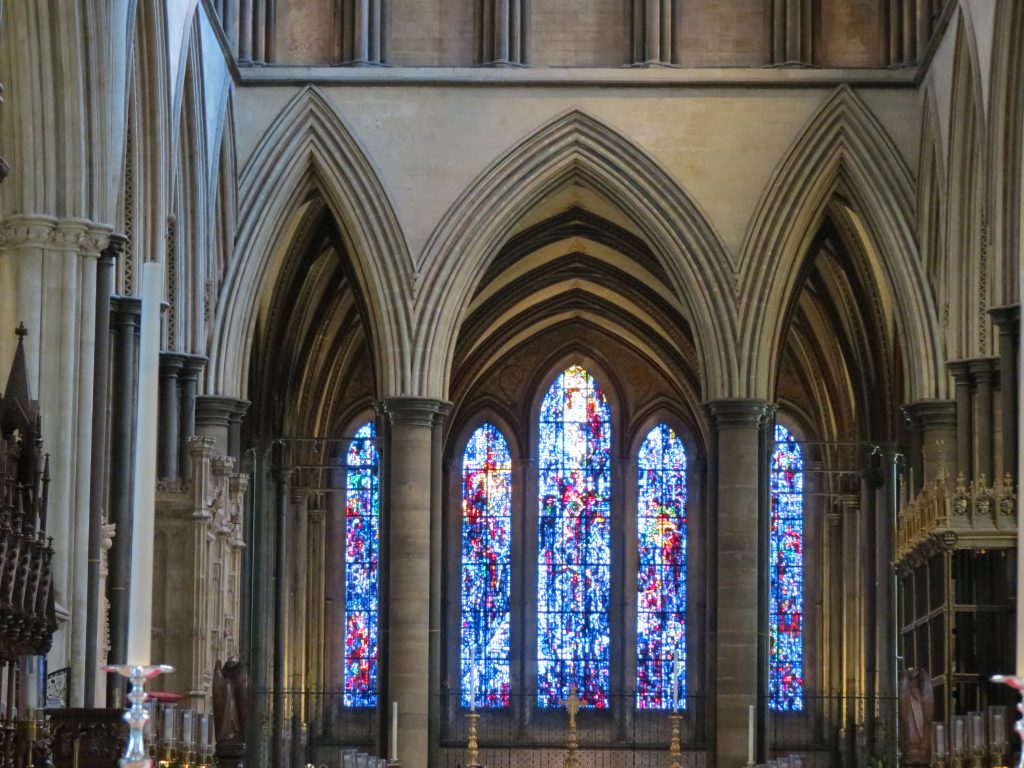
Music also speaks of God. The musical scales we use, four-part harmony, and the musical notation system were all developed to facilitate church singing. The pipe organ was developed from a rudimentary set of flutes to an engineering marvel because (until the synthesizer was invented) it was the only musical instrument which could play a note forever with no diminishment of sound. That’s important because the lack of any decay in sound was likened to the eternal nature of God!
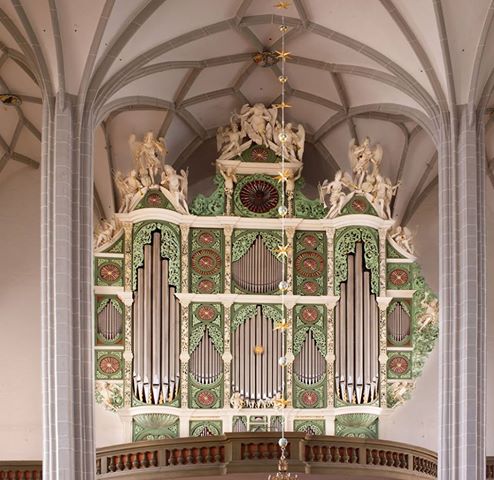
When literacy was low and Bibles were scarce, churches portrayed the biblical stories in art, particularly in stained glass windows. Parishioners could ‘read’ the Bible through their church’s art.
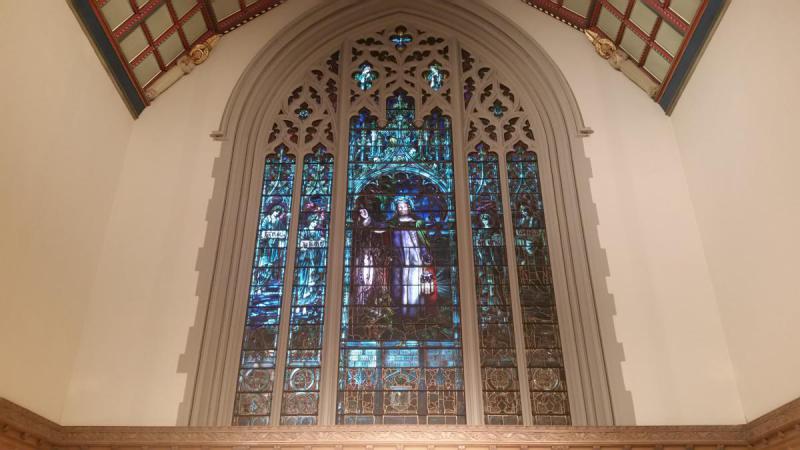
Now that we read the Bible itself, art serves to remind us of those stories and help us reflect on who God is and our relationship with him.
Why the Arts Are Important
Tom Wright makes a great case for why the church should support the arts:
“Part of the role of the church in the past was – and could and should be again – to foster and sustain lives of beauty and aesthetic meaning at every level, from music making in the village pub to drama in the local primary school, from artists’ and photographers’ workshops to still-life painting classes, from symphony concerts to driftwood sculptures. The church, because it is the family that believes in hope for new creation, should be the place in every town and village where new creation bursts forth for the whole community, pointing to the hope that, like all beauty, always comes as a surprise.” Tom Wright1.
Innovative Approaches to the Arts
The Pentecostal Assemblies of Newfoundland & Labrador (PAONL) made a serious commitment to the arts in 2012 when they purchased a commercial theatre. The venerable Majestic Theatre had been a cultural fixture in Saint John’s, NL for 190 years at that point. When it went out of business, the PAONL purchased the building and today they are close to finishing its refurbishment so it can be used again for live theatre. As I heard from PAONL about their plans for the theatre, I got excited about the possibilities. It will be used for church outreach events and for regular theatre productions. This is about the church showing support for its community and accomplishing its mission at the same time.

I recently visited Westside Church in Vancouver which is located in a former live theatre. A group of Christian business leaders bought the building and then dedicated it to the church for its own use and to rent it out for live, secular theatre productions. In fact, the venue is of such high quality that the Vancouver International Film Festival is held in the building. Hollywood producers and stars attending the festival are treated to a beautiful church facility complete with billboards for Children’s ministry and Small Group Bible studies, and of course, a large cross on the stage. Nothing is taken down when Hollywood comes to town!
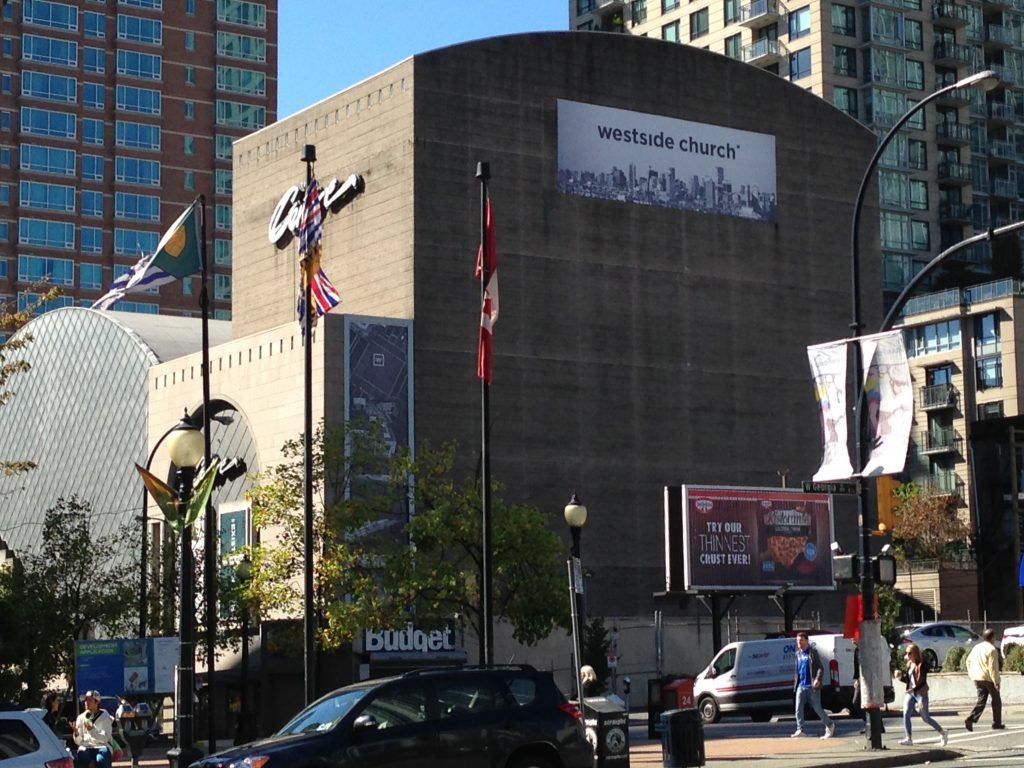
Christianity and the Arts
If you are interested in the historical details of the relationship between the church and the arts, How Christianity Changed the World is a good overview of how Christian faith shaped art, architecture, music, and literature, as well as science, medicine, education and so on.
And if you would like to explore more about Christian arts through history, there is an excellent coffee table book which surveys great works of Christian art, literature, music, and film through the millennia entitled 75 Masterpieces Every Christian Should Know. The stories behind each of the artistic selections are quite interesting, and you may (as I did) decide to delve deeper into the world of Christian art. This book is a great survey of a wide selection of art in its many forms. You’ll know what to look for and will appreciate its significance when you find it. The book covers everything from Michelangelo to Makoto Fujimura, from Mendelssohn to Bob Dylan, from the windows of Sainte-Chapelle to the writings of J.R.R. Tolkien. It’s a very engaging read!
How Art Can Be Used
Christian art doesn’t have to have explicit Christian imagery to be considered Christian and useful. It just needs to be created by a good artist who sees the world through Christian eyes.
Art Talks about God
In Art for God’s Sake: A Call to Recover the Arts, Philip Ryken says that art is capable of appealing to our longing for beauty. It communicates to Christians and others a portion of God’s beautiful creation. It draws our attention to parts of God’s creation that we may never personally see, or notice even if we do see it. Art can therefore be a subtle outreach to our culture. A lot of today’s art is created from a pessimistic view of the world and represents values at odds with Christian values. Christian art could have a more positive view based on different values, celebrating the positive world that God created and is re-creating through Jesus Christ.
As I look at the picture of the peacock below, I marvel that God created such a magnificent display of feathers. Why are there so many varieties of birds, as opposed to just one kind? Why are there such dramatic differences between a peacock, a cardinal, and a pigeon? The variety tells us something about God. He obviously likes variety and there are so many beautiful possibilities he imagined for designing a bird that he couldn’t design them all into just one species! So he gave us many. At least, that’s my guess.

Art Talks about Us
But in addition to the beauty of God’s creation, great Christian art can also portray the darkness and ugliness of a world caught in sin and separated from God. We can use art to to enhance our evangelism programs and to advocate on behalf of those who need our help. Uncle Tom’s Cabin is a good example of Christian advocacy literature. Images, plays, novels – all can help us understand who we are and our need for God’s love and forgiveness. I think the greatest single piece of Christian literature has got to be Les Misérables by Victor Hugo. I love this book! From cover to cover, God’s grace flows liberally through the story! Many people wouldn’t think of picking up the Bible, but they will pick up a novel.
Building Design
Here are two great examples of adding aesthetic value into the design of our churches. The first one is historical and the second is present day. For the best modern-day example that I know of, of incorporating art into church design and decoration, check out Southview Church in Calgary.
The central tower of Wells Cathedral was built in the early 1200s, and in 1313 was heightened by about thirty feet. Unfortunately, the pressure of the extra weight began to buckle the walls of the church and they had to be braced. Additional pillars would have served the purpose and been a utilitarian solution. But between 1338-1348, master mason William Joy designed and built the incredibly beautiful and unique “scissor-arches” that support the tower and add beauty. His solution to an engineering problem became the “trademark” of the Cathedral.
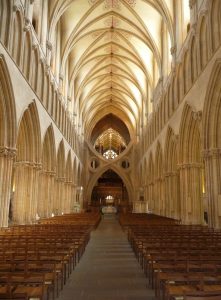
Brandon Malo, pastor of Elevation in Waterloo, ON told me the story of how his church came to meet in a beautiful sanctuary. When he needed a larger space for his church of young families, he visited St. John’s Lutheran church, a gorgeous stone church near downtown Waterloo. He by-passed the sanctuary and looked at the gym, which was what the congregation was used to, and thought it would be great for his church. When he brought his steering committee to see the gym, they never got past the sanctuary. Looking at its beauty, they said to him, “Why would you worship in a gym when you could be worshipping here?” He coordinated service times with the Lutherans and they now share the same delightful sanctuary!
Centre Street Church in Calgary needed a humidifier system for their building. They could have purchased equipment and done a standard job, but instead they chose to design a waterfall for their foyer. Not only do they have a beautiful attraction that doubles as a humidifier, but they also have a pool in which to do baptisms! A great job of bringing ‘living water’ indoors!
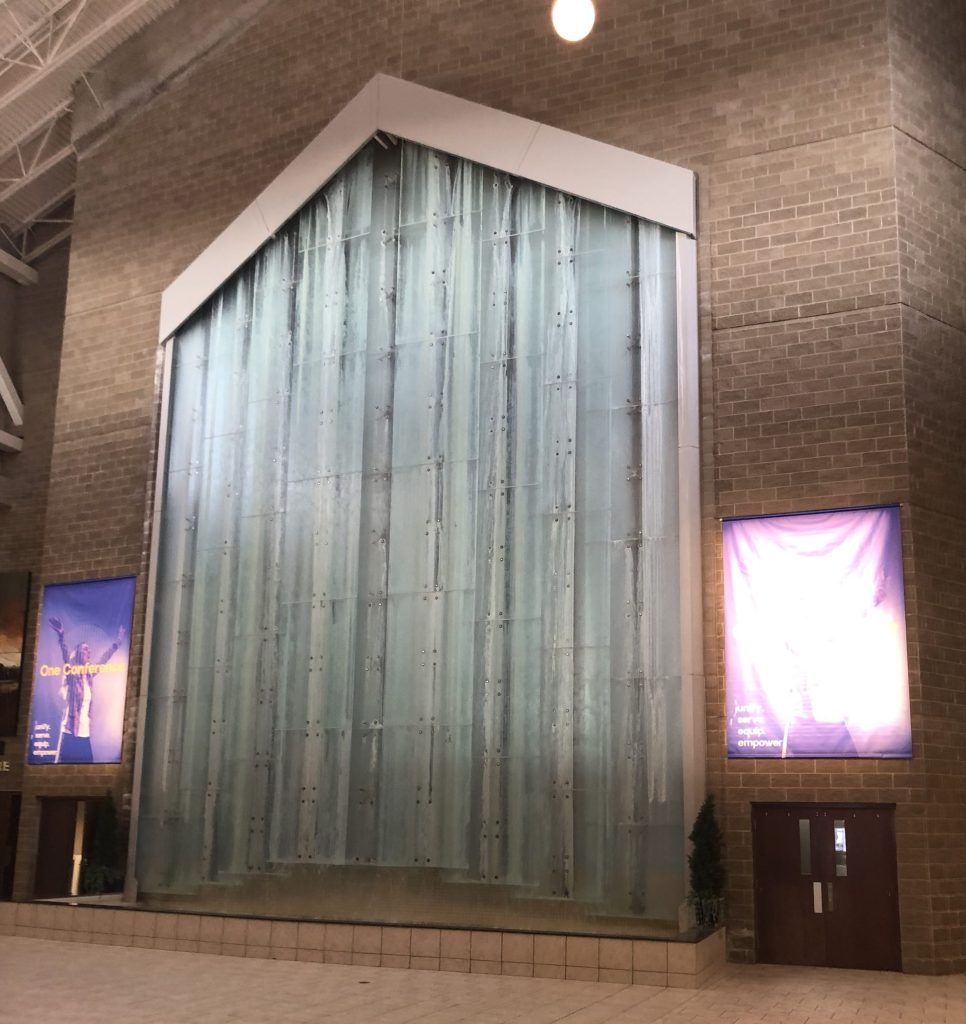
Now I’m not saying that we should be building cathedrals today. But could we pay more attention to the arts in the buildings we do have? The examples I’ve given so far come from large churches, but most churches today are small, between 50 to 200 people. However, even a small church can add beauty to its building. Maybe you won’t have a dramatic waterfall, but you could spruce it up with greenery or some artwork. Even just the way you paint your walls might add beauty.
I recently visited Journey Canada in Vancouver and this small office created an immediately favourable impression of their ministry through brightly coloured walls, a bold painting and a decorative brass vase. What a surprisingly beautiful sanctuary of sensory delight inside an old brick manufacturing building that used to house a coffin manufacturer!

Barrhead Church of God in Barrhead, AB has a stained glass picture mounted on a light box, which adds to the visual interest of their foyer.
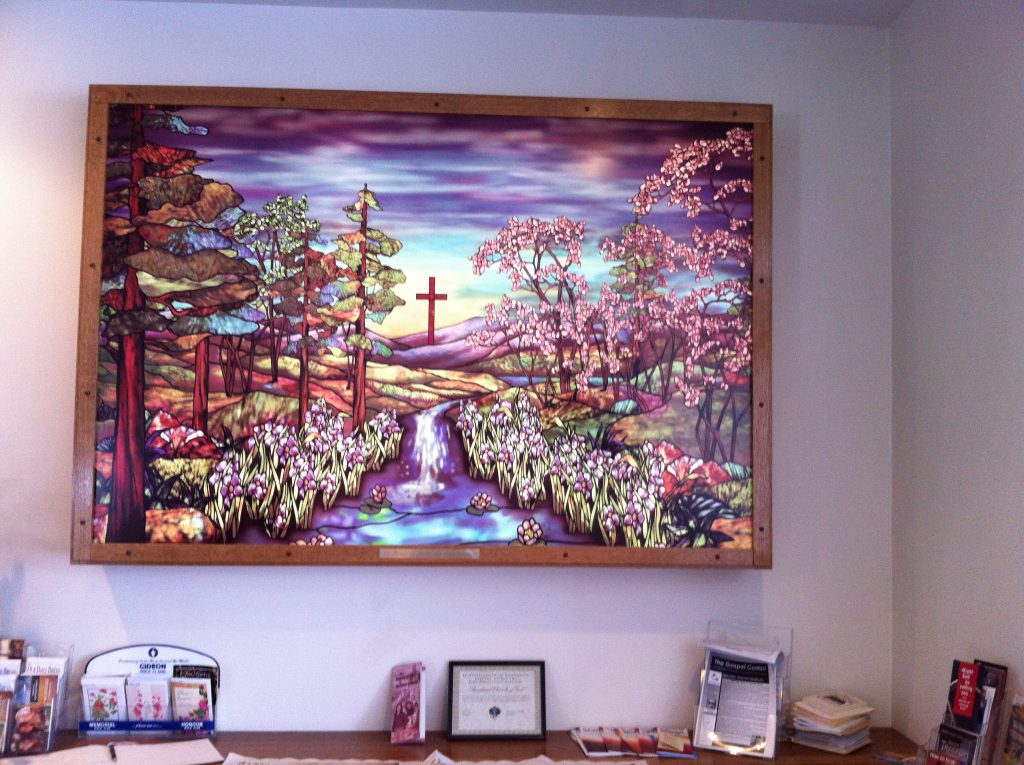
Art Distinguishes ‘Place’
Art lets people know they are somewhere distinctive. It denotes that “this place is different from other places.” James Davison Hunter writes that “when the physical places we inhabit look alike, place seems to matter even less. What was distinctive about a place [pales] into [an anonymous] space and we end up with what James Kunstler has called ‘a geography of nowhere’ – where every place looks like no place in particular.”2 Art can create places of wonder, awe, and mystery.
Art and the Poor
Ray Bakke has said that “The poor need beauty as well as bread.” According to Charlie Self, “It is not too expensive to invite artists and artisans, builders and craftsmen, to adorn the worship locale with color, light, and images that convey the mission, vision, and values of the community. Simplicity does not mean plainness, and good stewardship includes aesthetic leadership.”3
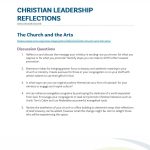
So what can we do?
First, here are three other articles with great ideas for how to support or use the arts:
- Comment magazine: The Church’s Role in Art
- RELEVANT magazine: 5 Ways the Church Can Make Art Great Again
- Faith Today magazine: Artful Discipleship: How the arts can help in spiritual formation
Display Their Visual Art
CCCC invited six young aspiring Christian artists to exhibit their work at The Pursuit ’16 conference. All of them made sales and took away leads for further work. This is an easy way to promote their careers and delight your members.
Yorkminster Park Baptist Church in Toronto actually has an art gallery in their church. It’s beautiful and tells visitors they care about the local arts community.
Buy Their Products/Services
Of course, you can directly promote their careers by purchasing their books, music, or visual art. Or hire them for an event. CCCC hired a Christian acting troupe to perform at the conference banquet this year. I personally purchased a painting from one of the young artists exhibiting at the conference. Click on the picture for “Dusk” and you will be taken to the artist’s gallery. And CCCC commissioned another of the artists to do an original piece of art for us: a starling murmuration, a very meaningful image for us. It speaks of community leadership, as I described (with a video) in my community leadership post.
Key Thought: Part of our witness to the world is showing how the beauty of our world reflects the beauty of God.
“The book, 75 Masterpieces Every Christian Should Know has been provided courtesy of Graf-Martin Communications, Inc. Available now at your favourite bookseller.”
- Tom Wright Surprised by Hope: Rethinking Heaven, the Resurrection, and the Mission of the Church
pp 231-2 ↩
- To Change The World p 239 ↩
- The quotes from Ray Bakke and Charlie Self come from Flourishing Churches & Communities by Charlie Self. p 17 ↩


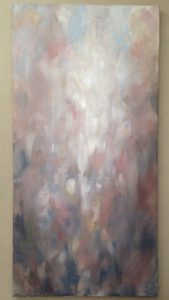

The church does not need the arts, it needs the Holy Spirit. I will not be tithing to the paonl anymore. Shame on you. Im embarrassed to say i go to a pentecostal church.
Hi Dave. Yes, the church needs the Holy Spirit, as I make the point in many posts.
In this post, the point is that for many years the Evangelical church has backed away the arts, vacated a significant part of God’s creation, and lost a powerful voice that can influence the secular world. The church needs to reclaim its place in influencing and shaping our world and not just leave it to secular people to shape the world. The Holy Spirit gives gifts and talents to the church which good stewardship and Christ’s call demands that we use for God’s glory.
Thank you for such an informative post. Appreciate this a lot. Yes! Church needs to support art!